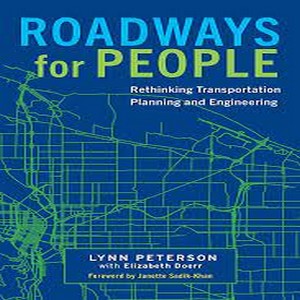Roadways for people rethinking transportation planning and engineering
by Lynn Peterson
Lynn Peterson’s Roadways for People is a treatise on the failings of highways to serve the communities they traverse. In their myopic purpose to move as many cars as possible—as quickly and safely as possible—scant consideration is given to whether these throughways harm the surrounding community, or if they even contextually fit their surroundings.
Peterson offers a handful of reasons why this has come to be. These include the narrow goals to which these roadway projects are designed as well as the design process itself, which gives only a cursory nod to public engagement. Finally, she cites the siloed nature in which transportation engineers and planners work as another reason why the needs and wishes of the community often are not meaningfully incorporated into the result of these projects.
The first chapter lays out Peterson’s thesis that the way many roadway and highway expansion projects are designed and carried out needs to change. The impact on the surrounding community—and opportunities to serve these communities—needs to be as important as the capacity and safety improvements of the roadway. She calls for effective and meaningful public engagement at the very beginning of the project and the need for funding to support community needs in relation to the roadway projects.
The second chapter gives a broad overview of different design and project delivery methods historically used by roadway engineers in America. This summary covers Context Sensitive Design, Performance-Based Practical Design, and Demand Management. Together, these methods, though devised to address different failings of the traditional roadway design and engineering approach, show an effort underway in the past 2 decades to exercise creativity and awareness of the broader needs of the community. The author notes these movements as steps in the right direction, but ultimately falling short of fully addressing the problems.
Chapter 3 addresses the legacy of racist transportation and housing policy in America and the need to assertively compensate for those past wrongs in today’s roadway projects. The discussion summarizes the racially discriminating effects of zoning, urban renewal, and gentrification as they intersect with transportation planning. Peterson concludes this chapter with eight suggestions on how to pursue equity through the work of planning transportation projects, though these suggestions are sufficiently broad to apply to any planning exercise. Similarly, Chapter 4 posits the need for planners to seek collaboration to address issues, engender trust with partners, and hold tightly to professional ethics (citing the American Society of Civil Engineers’s ethical principles promoting equitable participation). Again, Peterson concludes this chapter with several suggestions on how to break down silos in the planning of transportation projects.
In Chapter 5, Peterson brings together all the topics addressed in previous chapters to outline an improved project design pathway, centered around thorough stakeholder involvement at multiple stages of the planning and design process. She calls this process the Community Solutions Based approach. As with the previous chapters, her ideas are punctuated with real-world examples and discussion of key roadway expansion projects from around the country. While the project examples provided were not developed from start to finish using the author’s process, they serve to highlight different key actions in her project design path and how those actions positively impacted the result of the project. The result is a step-by-step walkthrough of her Community Solutions Based process, narrated through how each stage unfolded in a real project example.
Lastly, in her concluding chapter, Peterson notes the federal government’s recent historic investments in the country’s infrastructure. She claims this is a once-in-a-lifetime opportunity that, if carried out carefully and with the communities’ needs in mind, can result in a profound positive change in our cities, towns, and neighborhoods.
Lynn Peterson has more than 30 years’ experience in transportation planning and engineering beginning with her early career in Wisconsin to her years of work in Oregon. She draws on this experience and uses several projects in which she has been involved to bring the various challenges she discusses to life. Her viewpoint is that of a practitioner who has come upon the revelations in her book through experience and reflection on the many projects the author has seen or been a part of. Each project highlighted in the book offers up lessons that lead step-by-step to the author’s unveiling of her suggested project design process.
I believe this book is useful as a text as part of a transportation planning course in an urban planning or civil engineering curriculum. It is not overly technical or reliant on inside knowledge of roadway design or engineering principles. The different historical design methodologies are adequately described in such a way as not to need outside reference for context. Each chapter (save for Chapter 5) is consistent in length at 25–30 pages focused on a particular topic. There are illustrations located throughout the text which help the reader visualize the different project examples referenced. Also, key conclusions are often punctuated with bulleted lists, which deliver the main points of each chapter or section to the reader in a concise way.





Reviews
There are no reviews yet.